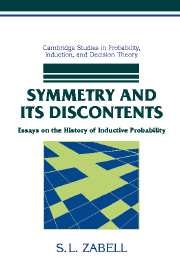Book contents
- Frontmatter
- Contents
- Preface
- PART ONE PROBABILITY
- PART TWO PERSONALITIES
- 5 The Birth of the Central Limit Theorem [with Persi Diaconis]
- 6 Ramsey, Truth, and Probability
- 7 R. A. Fisher on the History of Inverse Probability
- 8 R. A. Fisher and the Fiducial Argument
- 9 Alan Turing and the Central Limit Theorem
- PART THREE PREDICTION
- Index
6 - Ramsey, Truth, and Probability
Published online by Cambridge University Press: 05 June 2012
- Frontmatter
- Contents
- Preface
- PART ONE PROBABILITY
- PART TWO PERSONALITIES
- 5 The Birth of the Central Limit Theorem [with Persi Diaconis]
- 6 Ramsey, Truth, and Probability
- 7 R. A. Fisher on the History of Inverse Probability
- 8 R. A. Fisher and the Fiducial Argument
- 9 Alan Turing and the Central Limit Theorem
- PART THREE PREDICTION
- Index
Summary
Frank Ramsey's essay “Truth and Probability” represents the culmination of a long tradition at Cambridge of philosophical investigation into the foundations of probability and inductive inference; and in order to appreciate completely both the intellectual context within which Ramsey wrote, and the major advance that his essay represents, it is essential to have some understanding of his predecessors at Cambridge. One of the primary purposes of this paper is to give the reader some sense of that background, identifying some of the principal personalities involved and the nature of their respective contributions; the other is to discuss just how successful Ramsey was in his attempt to construct a logic of partial belief.
“Truth and Probability” has a very simple structure. The first two sections of the essay discuss the two most important rival theories concerning the nature of probability that were current in Ramsey's day, those of Venn and Keynes. The next section then presents the alternative advocated by Ramsey, the simultaneous axiomatization of utility and probability as the expression of a consistent set of preferences. The fourth section then argues the advantages of this approach; and the last section confronts the problem of inductive inference central to English philosophy since the time of Hume. The present paper has a structure parallel to Ramsey's; each section discusses the corresponding section in Ramsey's paper.
ELLIS AND VENN
Ramsey's essay begins by disposing of the frequentist and credibilist positions; that is, the two positions advocated by his Cambridge predecessors John Venn (in The Logic of Chance, 1866) and John Maynard Keynes (in his Treatise on Probability, 1921); and thus the two positions certain to be known to his audience.
- Type
- Chapter
- Information
- Symmetry and its DiscontentsEssays on the History of Inductive Probability, pp. 119 - 141Publisher: Cambridge University PressPrint publication year: 2005



